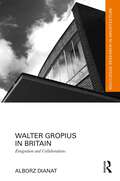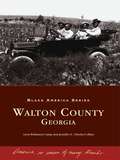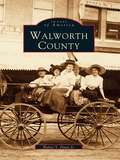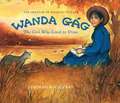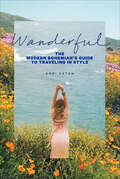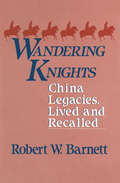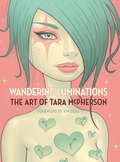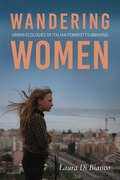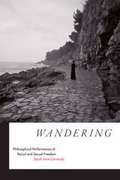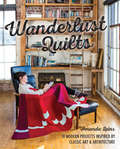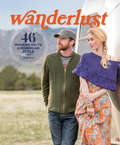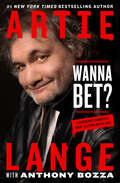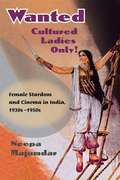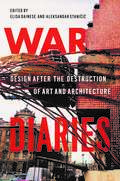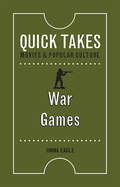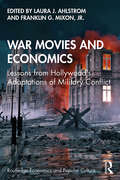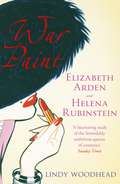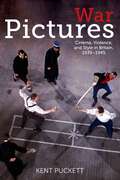- Table View
- List View
Walter Gropius in Britain: Emigration and Collaborations (Routledge Research in Architecture)
by Alborz DianatAs the first monograph dedicated to Walter Gropius’s activity in Britain, this book provides a comprehensive account of the Bauhaus founder’s contributions to architecture and design while living in London between 1934 and 1937. Drawing on earlier and later decades, this reveals the close contact between British, German and American design circles, with Gropius bridging parallel developments.In its approach, this book concentrates on the individuals working to aid Gropius in Britain and spurring the architect’s enduring dominance in English‑language histories. This includes his architectural partner Maxwell Fry, his translator P. Morton Shand, his employer Jack Pritchard and many other prominent figures such as Frank Pick, Herbert Read, Elizabeth Denby and Henry Morris. The vital role of Gropius’s wife Ise is also highlighted, particularly as her English‑language capabilities far exceeded his. By uncovering this wider network, the collaborative nature of his success is demonstrated. Such an approach reveals Gropius’s contributions beyond buildings to various debates in the period. These spanned subjects including standardisation, prefabrication, democratisation, the planning of high rises, the influence of commercialism, and the reform of architectural education and practice. Beyond design discourse, the broader impact of nationalism is considered, with the support Gropius received contrasted against the attacks Jewish émigrés endured.This book will appeal to those interested in the Bauhaus, interwar Britain, architectural media and emigration studies. By applying revisionist approaches and highlighting the importance of discourse beyond built forms, this book advances our knowledge of the period. The transnational focus holds significance for architectural developments in Germany, Britain and America, following Gropius’s trajectory. While concentrated primarily on the interwar period, the postwar impact of exchanges is revealed, leading up until Gropius’s death in 1969.
Walton County, Georgia (Black America Series)
by Jennifer E. Cheeks-Collins Lynn Robinson CampSituated between Atlanta and Athens, Walton County has always been a stronghold of the cotton industry. While some of the largest cotton crops in the world have emerged from its fertile fields, a strong community and storied history have come to define the county. Recognized as the site of America's last mass-lynching at Moore's Ford in 1946, Walton County has been a focal point of national attention, sparking changes that have contributed to the nation's Civil Rights movement.But it is not only this tragedy that has given Walton County a sense of identity. Indeed, other lesser-known events and accomplishments have contributed to its history. Whether boasting Atlanta's first black millionaire, a member of the U.S. Olympic basketball team, or a high school state football championship, Walton County has thrived both in and out of the national spotlight.
Walworth County (Images of America)
by Walter S. Dunn Jr.From 1870 to 1950, Walworth County, Wisconsin, experienced a period of dramatic social change. This fascinating collection of photographs provides avisual journey through time, depicting major changes in transportation and its effects on the beautiful shores of Lake Geneva. Developments in the railroad provided a huge catalyst for change before the turn of the century. Farmers were able to ship milk to Chicago and the annual influx of summer residents from the Chicago area quickly grew with the easy access to Lake Geneva's wealthy south shore. The advent of the automobile sparked a second radical change in the face of the county, opening up a vast radius of the Midwest to families who had once been restricted by the horse-drawn wagon. The oneroom school became a thing of the past, and the lakes became popular destinations for weekend visitors set to enjoy the leisurely pursuits of boating and fishing.
Wanda Gág: The Girl Who Lived to Draw
by Deborah Kogan RayWanda Gág (pronounced Gog) is well known as the author and illustrator of "Millions of Cats," one of the best-loved children's books ever published. But not many people know how interesting and inspiring her life was. Following in the footsteps of her beloved artist father, Wanda led an idyllic childhood, drawing and listening to old-world fairy tales. But when her father died, it was teenage Wanda who worked hard to keep her seven younger siblings fed, clothed, and laughing. She never lost sight of her love of art, however, and her tremendous willpower won her a coveted scholarship to the Art Students League in New York City and then led to a gallery show of her artwork where an editor of children's books got an idea for a book. The rest, as they say, is history!
Wanderful: The Modern Bohemian's Guide to Traveling in Style
by Andi EatonA girl with a love for off-the-beaten-path destinations, fashion maven Andi Eaton found herself putting aside the Lonely Planet and Condé Nast Traveler guides and, instead, looking to bohemians and artists for travel and style inspiration: What do the flower children wear on their excursions? Where are the creatives’ favorite vintage shops? And where do the musicians go late-night dancing after the last encore? The dreamer in her wanted more than what a standard travel guide could offer, so she decided to create her own. Wanderful is a stylish lookbook and travelogue for the adventurous and nomadic at heart. Follow in Andi’s footsteps as she travels the United States to discover some of its most effortlessly chic destinations—and the fashionable free spirits and wanderers who live there. Nine intimate and exciting road trip routes explore cities, forests, and in between, and will make you feel like you’re traipsing the country with your best, and best-dressed, girlfriends by your side. Every route features a peek into the closets of area tastemakers, and many routes lead to favorite trendy destinations, including Joshua Tree, New Orleans, Marfa, and Santa Fe. Throughout, there are photos, stories, and recommendations for where to shop, dine, and find music and fun, just like a local.
Wandering Knights: China Legacies, Lived and Recalled
by Robert W. BarnettA memoir of China during World War II, when Barnett, a US airman, shared friendship and scholarly interests with a young Chinese historian. They translated part of an ancient Chinese history, and met again in 1982. Annotation copyright Book News, Inc. Portland, Or.
Wandering Luminations: The Art of Tara McPherson
by Tara McPhersonTara McPherson returns with another stunning art book!The chaotic wonders of science, mythology and the power of the feminine form are at the core of this stunning art collection. Wandering Luminations: The Art of Tara McPherson showcases the artist's most recent and ambitious creations from that solo exhibition, as well as works from her I Know It By Heart and Supernova series of paintings.
Wandering Women: Urban Ecologies of Italian Feminist Filmmaking (New Directions in National Cinemas)
by Laura Di BiancoWandering Women: Urban Ecologies of Italian Feminist Filmmaking explores the work of contemporary Italian women directors from feminist and ecological perspectives. Mostly relegated to the margins of the cultural scene, and concerned with women's marginality, the compelling films Wandering Women sheds light on tell stories of displacement and liminality that unfold through the act of walking in the city. The unusual emptiness of the cities that the nomadic female protagonists traverse highlights the absence of, and their wish for, life-sustaining communities. Laura Di Bianco contends that women's urban filmmaking—while articulating a claim for belonging and asserting cinematic and social agency—brings into view landscapes of the Anthropocene, where urban decay and the erasure of nature intersect with human alienation. Though a minor cinema, it is also a powerful movement of resistance against the dominant male narratives about the world we inhabit.Based on interviews with directors, Wandering Women deepens the understanding of contemporary Italian cinema while enriching the field of feminist ecocritical literature.
Wandering: Philosophical Performances of Racial and Sexual Freedom
by Sarah Jane CervenakCombining black feminist theory, philosophy, and performance studies, Sarah Jane Cervenak ruminates on the significance of physical and mental roaming for black freedom. She is particularly interested in the power of wandering or daydreaming for those whose mobility has been under severe constraint, from the slave era to the present. Since the Enlightenment, wandering has been considered dangerous and even criminal when associated with people of color. Cervenak engages artist-philosophers who focus on wayward movement and daydreaming, or mental travel, that transcend state-imposed limitations on physical, geographic movement. From Sojourner Truth's spiritual and physical roaming to the rambling protagonist of Gayl Jones's novel Mosquito, Cervenak highlights modes of wandering that subvert Enlightenment-based protocols of rationality, composure, and upstanding comportment. Turning to the artists Pope.L (William Pope.L), Adrian Piper, and Carrie Mae Weems, Cervenak argues that their work produces an otherworldly movement, an errant kinesis that exceeds locomotive constraints, resisting the straightening-out processes of post-Enlightenment, white-supremacist, capitalist, sexist, and heteronormative modernity. Their roaming animates another terrain, one where free, black movement is not necessarily connected to that which can be seen, touched, known, and materially valued.
Wanderlust Quilts: 10 Modern Projects Inspired by Classic Art & Architecture
by Amanda LeinsArchaeology and crafts combine with these modern quilt and pillow projects inspired by classic art and architecture from around the world.Travel the world without leaving your studio! Tour ancient Greece, Rome, and Israel by way of 10 modern quilts designed from classical art and architecture, while you savor the stories and photos that inspired them. Infused with the mystery of the past, these timeless projects will help you grow as a quilter and move beyond the basics. Explore advanced techniques, including curved piecing, Y-seams, scalloped binding, and more.&“Leins creatively pays homage to the aqueducts of the Coliseum, the inner dome of the Pantheon, or the cobblestones on a street…&“Flowing Fabric&” honors the caryatids on the Erectheum; &“Layered Conversations&” draws on heaps in old urban landscapes. Lein&’s goals include showing that people all over the world, then and now, exploit &“the same language of pattern,&” including catenary arches, herringbones, and squares within squares.&”—Publishers Weekly
Wanderlust: 46 Modern Knits for Bohemian Style
by Tanis GrayExplore 46 new knitting patterns that celebrate bohemian style! Let Wanderlust take you on a journey through 46 delightful knitting patterns! Discover a wide range of knitting projects, including knit cowls, scarves, shawls, hats, mittens, and sweaters. Ideal for knitted gifts, the projects range from easy garter stitch and stockinette to pretty lace patterns, chunky cables, simple colorwork, and more. All of the knitting designs in Wanderlust are made with 100% superwash extrafine merino wool--perfect for active modern lifestyles. With quick accessories and garments for both men and women, including seven glorious sweaters, you will find something for everyone on your knitting list, and more importantly, for yourself!
Wang Wei the Painter-Poet
by Dorothy Brush Walmsley Lewis Calwin WalmsleyThe time has now come, we believe, for enthusiasts to welcome books on individual Chinese artists, such as this distinctive study of Wang Wei, the Painter-Poet. This story of a great man and his work, who lived in a period of history long before the New World had even produced a history, is simply presented; however, care has been taken not to deviate from historical accuracy.
Wang Wei the Painter-Poet
by Dorothy Brush Walmsley Lewis Calwin WalmsleyThe time has now come, we believe, for enthusiasts to welcome books on individual Chinese artists, such as this distinctive study of Wang Wei, the Painter-Poet. This story of a great man and his work, who lived in a period of history long before the New World had even produced a history, is simply presented; however, care has been taken not to deviate from historical accuracy.
Wang Wei the Painter-Poet
by Dorothy Brush Walmsley Lewis Calwin WalmsleyThis Chinese art history book is a study of a single poet-artist--Wang Wei--perhaps the most influential of antiquity.This eighth-century genius, whose versatility is comparable to that of the great Italian Leonardo da Vinci, lived during the Tang Dynasty when the most brilliant cultural period in Chinese history was at its height.Whatever he attempted--as artist, poet, musician, doctor and official--he performed with a master's touch. As a poet he earned the title of "Great." He is acknowledged as the father of pure Chinese landscape painting., destined to become classic throughout the world. Wang's initiative in monochromes and his advanced skills in techniques were harbingers of different types of paintings.Greatest of all his innovations is the long horizontal Chinese scroll, reaching a length, in some instances, of over twenty feet.
Wanksy: Interpreting a Graffiti Virtuoso
by James Harris Marc BlakewillWanksy is the unheralded genius behind some of our most iconic urban images: the seminal ‘cock and balls’ and other masterpieces. For the first time, this book collects Wanksy’s most significant works together with expert critiques that illuminate their hidden depths. You’ll never look at a crudely drawn penis in the same way again.
Wanksy: Interpreting a Graffiti Virtuoso
by James Harris Marc BlakewillWanksy is the unheralded genius behind some of our most iconic urban images: the seminal ‘cock and balls’ and other masterpieces. For the first time, this book collects Wanksy’s most significant works together with expert critiques that illuminate their hidden depths. You’ll never look at a crudely drawn penis in the same way again.
Wanksy: Interpreting a Graffiti Virtuoso
by James Harris Marc BlakewillWanksy is the unheralded genius behind some of our most iconic urban images: the seminal ‘cock and balls’ and other masterpieces. For the first time, this book collects Wanksy’s most significant works together with expert critiques that illuminate their hidden depths. You’ll never look at a crudely drawn penis in the same way again.
Wanna Bet?: A Degenerate Gambler's Guide to Living on the Edge
by Artie Lange Anthony Bozza"Lange’s entertaining book makes it clear that, no matter how wild and risky his lifestyle may be, he takes comedy more seriously than anything else." —Publishers WeeklyWhen Artie Lange's first book, the #1 New York Times bestseller, Too Fat To Fish, hit the top of the charts, audiences learned what Howard Stern listeners already knew: that Artie is one of the funniest people alive. He is also an artist haunted by his fair share of demons, which overtook him in the years that followed. After a suicide attempt, a two-year struggle with depression, and years of chronic opiate addiction, Artie entered recovery and built himself back up, chronicling his struggle in brave detail in his next book and second New York Times bestseller, Crash and Burn.In his hilarious third book, the two-time bestselling author, comedian, actor, and radio icon explains the philosophy that has kept his existence boredom-free since the age of 13—the love of risk. An avid sports better and frequent card player, Lange believes that the true gambler gets high not from winning, but from the chaotic unknown of betting itself. He recounts some of his favorite moments, many of which haven't involved money at all. In this candid and entertaining memoir, he looks back at the times he's wagered the intangible and priceless things in life: his health, his career, and his relationships. The stories found in Wanna Bet? paint a portrait of a man who would just as quickly bet tens of thousands of dollars on a coin toss as he would a well thought out NBA or NFL wager. Along for the ride are colorful characters from Artie's life who live by the same creed, from a cast of childhood friends to peers like comedian and known gambler Norm McDonald. The book is a tour of a subculture where bookies and mobsters, athletes and celebrities ride the gambling roller coaster for the love of the rush. Through it all, somehow Artie has come out ahead, though he does take a few moments to imagine his life if things hadn't quite gone his way. Unrepentant and unrestrained, the book is Lange at his finest.
Wanted Cultured Ladies Only!: Female Stardom and Cinema in India, 1930s-1950s
by Neepa MajumdarWanted Cultured Ladies Only! maps out the early culture of cinema stardom in India from its emergence in the silent era to the decade after Indian independence in the mid-twentieth century. Neepa Majumdar combines readings of specific films and stars with an analysis of the historical and cultural configurations that gave rise to distinctly Indian notions of celebrity. She argues that discussions of early cinematic stardom in India must be placed in the context of the general legitimizing discourse of colonial "improvement" that marked other civic and cultural spheres as well, and that "vernacular modernist" anxieties over the New Woman had limited resonance here. Rather, it was through emphatically nationalist discourses that Indian cinema found its model for modern female identities. Considering questions of spectatorship, gossip, popularity, and the dominance of a star-based production system, Majumdar details the rise of film stars such as Sulochana, Fearless Nadia, Lata Mangeshkar, and Nargis
War Diaries: Design after the Destruction of Art and Architecture
by Elisa Dainese Aleksandar StanicicIn recent decades, the development of advanced weaponry systems and the instant flow of information have redefined the notion of urban warfare as a local phenomenon with global effects in an increasingly interconnected world. The annihilation of Aleppo and the broadcasted demolitions of Palmyra demonstrate the accelerating politicization of the destruction process. In this timely volume, Elisa Dainese, Aleksandar Staničić, and a broad range of contributors explore the weaponization of architecture—targeted attacks on art and infrastructure meant to destroy not only physical structures but also political unity and cultural memory. Focusing on regions where planners, architects, and artists are involved in concrete initiatives on the ground, War Diaries looks at complex postwar settings to illuminate design responses to urban warfare and violence against the built environment. The essays discuss creative strategies for rebuilding and restablizing damaged sites, often within the context of continuing animosities; the establishment of design coalitions to work with local communities on reconstruction; the designing of emergency settlements; the development of new and customized strategies for rebuilding diverse parts of the ravaged world; and the teaching of culturally sensitive design practices to architects and urbanists, among many other topics. A much-needed contribution to our understanding of postconflict design, this volume maps the creative approaches that specialists have used to remediate the effects of violence against cities and cultural heritage.
War Games (Quick Takes: Movies and Popular Culture)
by Jonna EagleThe word “wargames” might seem like a contradiction in terms. After all, the declaration “This is war” is meant to signal that things have turned deadly serious, that there is no more playing around. Yet the practices of war are intimately entangled with practices of gaming, from military videogames to live battle reenactments. How do these forms of play impact how both soldiers and civilians perceive acts of war? This Quick Take considers how various war games and simulations shape the ways we imagine war. Paradoxically, these games grant us a sense of mastery and control as we strategize and scrutinize the enemy, yet also allow us the thrilling sense of being immersed in the carnage and chaos of battle. But as simulations of war become more integrated into both popular culture and military practice, how do they shape our apprehension of the traumatic realities of warfare? Covering everything from chess to football, from Saving Private Ryan to American Sniper, and from Call of Duty to drone interfaces, War Games is an essential guide for anyone seeking to understand the militarization of American culture, offering a compact yet comprehensive look at how we play with images of war.
War Movies and Economics: Lessons from Hollywood’s Adaptations of Military Conflict (Routledge Economics and Popular Culture Series)
by Laura J. AhlstromWar Movies and Economics: Lessons from Hollywood’s Adaptations of Military Conflict applies ongoing research in the relatively new genre of economics in popular media to Hollywood’s war movies. Whether inadvertently or purposefully, these movies provide numerous examples of how economic principles often play an important role in military conflict. The authors of the chapters included in this edited collection work to illustrate economics lessons portrayed in adaptations such as Band of Brothers, Conspiracy, The Dirty Dozen, Dunkirk, Memphis Belle, Saving Private Ryan, Schindler’s List, Spartacus, Stalag 17, and Valkyrie. Aspects of these stories show how key economic principles of scarcity, limited resources, and incentives play important roles in military conflict. The movies also provide an avenue for discussion of the economics of public goods provision, the modern economic theory of bureaucracy, and various game-theoretic concepts such as strategic moves and commitment devices. Where applicable, lessons from closely related fields such as management are also provided. This book is ideal reading for students of economics looking for an approachable route to understanding basic principles of economics and game theory. It is also accessible to amateur and professional historians, and any reader interested in popular culture as it relates to television, movies, and military history.
War Paint: Elizabeth Arden and Helena Rubinstein: Their Lives, their Times, their Rivalry
by Lindy WoodheadWar Paint is the story of two extraordinary women, Miss Elizabeth Arden and Madame Helena Rubinstein, and the legacy they left: a story of feminine vanity and marketing genius. Behind the gloss and glamour lay obsession with business and rivalry with each other. Despite working for over six decades in the same business, these two geniuses never met face to face - until now. 'The definitive biography of women and their relationships to their faces in the twentieth century' Linda Grant, Guardian'I have seldom enjoyed a book so much . . . the research is staggering . . . a wonderful read' Lulu Guinness
War Photographs Taken on the Battlefields of the Civil War: A Collection Of Memorable Civil War Images Photographed By Mathew Brady And His Assistants (Lyons Press Ser.)
by Alexander Gardner Mathew B. BradyFought over the course of four years, the Civil War pitted countrymen against countrymen, North versus South, friend against friend, and brother against brother. The photographs within these pages document the war that united America as one.These rare shots were taken in the middle of the battlefield during the earliest days of photography. Selected from a collection of seven thousand original negatives, these historic photos capture nearly every aspect of Civil War life. Among these photos are images of camps sprawling across acres, soldiers at their battlements, firing of heavy artillery, the aftermath of battle, and the terror that these young men faced. See first-hand of Union and Confederate officers strategizing their next moves, and Abraham Lincoln addressing his Union commanders.Originally released from the private collection of Edward Bailey Eaton in 1907, this edition is a must have for any Civil War buff or historian. No collection can be considered complete without these photographs by Matthew Brady and Alexander Gardner, as well as the meticulous passages that put the images in illuminating context.
War Pictures: Cinema, Violence, and Style in Britain, 1939-1945 (World War II: The Global, Human, and Ethical Dimension)
by Kent PuckettIn this original and engaging work, author Kent Puckett looks at how British filmmakers imagined, saw, and sought to represent its war during wartime through film. The Second World War posed unique representational challenges to Britain’s filmmakers. Because of its logistical enormity, the unprecedented scope of its destruction, its conceptual status as total, and the way it affected everyday life through aerial bombing, blackouts, rationing, and the demands of total mobilization, World War II created new, critical opportunities for cinematic representation.Beginning with a close and critical analysis of Britain’s cultural scene, War Pictures examines where the historiography of war, the philosophy of violence, and aesthetics come together. Focusing on three films made in Britain during the second half of the Second World War—Michael Powell and Emeric Pressburger’s The Life and Death of Colonel Blimp (1943), Lawrence Olivier’s Henry V (1944), and David Lean’s Brief Encounter (1945)—Puckett treats these movies as objects of considerable historical interest but also as works that exploit the full resources of cinematic technique to engage with the idea, experience, and political complexity of war. By examining how cinema functioned as propaganda, criticism, and a form of self-analysis, War Pictures reveals how British filmmakers, writers, critics, and politicians understood the nature and consequence of total war as it related to ideas about freedom and security, national character, and the daunting persistence of human violence. While Powell and Pressburger, Olivier, and Lean developed deeply self-conscious wartime films, their specific and strategic use of cinematic eccentricity was an aesthetic response to broader contradictions that characterized the homefront in Britain between 1939 and 1945. This stylistic eccentricity shaped British thinking about war, violence, and commitment as well as both an answer to and an expression of a more general violence.Although War Pictures focuses on a particularly intense moment in time, Puckett uses that particularity to make a larger argument about the pressure that war puts on aesthetic representation, past and present. Through cinema, Britain grappled with the paradoxical notion that, in order to preserve its character, it had not only to fight and to win but also to abandon exactly those old decencies, those “sporting-club rules,” that it sought also to protect.
